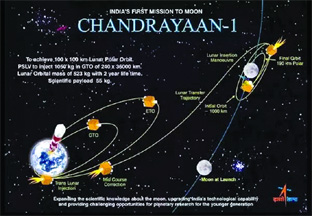

Chandrayaan, meaning “mooncraft” in Sanskrit, represents India’s lunar exploration program launched by the Indian Space Research Organisation (ISRO). The Chandrayaan program aims to study the moon’s surface, minerals, water ice presence, and enhance India’s space capabilities. There have been three missions so far with a total of two orbiters, landers and rovers each. While the two orbiters were successful, the first lander and rover which were part of the Chandrayaan-2 mission, crashed on the surface. The current Chandrayaan-3 mission’s rover “ramped down” from the lander and “India took a walk on the Moon!”, the ISRO said. The Vikram lander successfully touched down as planned on Wednesday, August 23, evening.
With this, India joins an elite club of countries to achieve a soft landing on the Moon, after the US, the former Soviet Union and China.
Program structure
The Chandrayaan (Indian Lunar Exploration Programme) is a multiple mission programme. As of September 2019, one orbiter with an impactor probe has been sent to the Moon, using ISRO’s workhorse PSLV rocket. The second spacecraft consisting of orbiter, soft lander and rover was launched on 22 July 2019, by using a LVM3 rocket. The Chandrayaan-3 mission was launched in 14 July 2023 using LVM-3.
Phase I: Orbiter and Impactor
Chandrayaan-1
Prime Minister Atal Bihari Vajpayee announced the Chandrayaan project on course in his Independence Day speech on 15 August 2003. The mission was a major boost to India’s space program. The idea of an Indian scientific mission to the Moon was first mooted in 1999 during a meeting of the Indian Academy of Sciences. The Astronautical Society of India carried forward the idea in 2000. Soon after, the Indian Space Research Organisation (ISRO) set up the National Lunar Mission Task Force which concluded that ISRO has the technical expertise to carry out an Indian mission to the Moon. In April 2003 over 100 eminent Indian scientists in the fields of planetary and space sciences, Earth sciences, physics, chemistry, astronomy, astrophysics and engineering and communication sciences discussed and approved the Task Force recommendation to launch an Indian probe to the Moon. Six months later, in November, the Indian government gave the nod for the mission.
Chandrayaan-1, launched on 22 October 2008 aboard a PSLV-XL rocket, was a big success for ISRO as the Moon Impact Probe, a payload on board the Chandrayaan-1 spacecraft, discovered water on the Moon. Apart from detecting water the Chandrayaan-1 mission performed several other tasks such as mapping and atmospheric profiling of the Moon.
Phase II: Soft landers, rovers
Chandrayaan-2
On 18 September 2008, the First Manmohan Singh Cabinet approved the mission. Although ISRO finalised the payload for Chandrayaan-2 per schedule, the mission was postponed in January 2013[10] and rescheduled to 2016 because Russia was unable to develop the lander on time.
Roscosmos later withdrew in wake of the failure of the Fobos-Grunt mission to Mars, since the technical aspects connected with the Fobos-Grunt mission were also used in the lunar projects, which needed to be reviewed. When Russia cited its inability to provide the lander even by 2015, India decided to develop the lunar mission independently and unused orbiter hardware was repurposed to be used for Mars Orbiter Mission.
Chandrayaan-2 was launched on 22 July 2019 aboard a LVM3 rocket. The spacecraft was successfully put into lunar orbit on August 20, 2019 but the lander was lost while attempting to land on 6 September 2019. The orbiter is operational, collecting scientific data, and is expected to function for 7.5 years.
Chandrayaan-3
In November 2019, ISRO officials stated that a new lunar lander mission was being studied for launch in November 2020. This new proposal is called Chandrayaan-3 and it would be a re-attempt to demonstrate the landing capabilities needed for the Lunar Polar Exploration Mission proposed in partnership with Japan for 2025. This spacecraft configuration would not include launching an orbiter and would have a lander, rover, and a propulsion module with mission costing Rs 250 crore with additional launch costs of Rs 365 crore for LVM3.
Chandrayaan-3 was launched on 14 July 2023 at 9:05:17 UTC. The primary goals of the Chandrayaan-3 mission encompass three key aspects. Firstly, it aims to showcase a successful and controlled touchdown on the lunar surface. Secondly, it intends to demonstrate the mobility of a rover on the Moon’s terrain. Lastly, it seeks to carry out scientific experiments directly on the lunar surface.
India’s Space Ambitions
Chandrayaan missions showcase India’s growing space capabilities and technological advancements.
Successes and setbacks alike contribute to the nation’s experience and expertise in space exploration.
Future Lunar Endeavors
Chandrayaan program is expected to pave the way for more ambitious lunar missions in the future.
India aims to continue expanding its lunar exploration capabilities and contribute to global lunar research efforts.
International Recognition
Chandrayaan missions have earned India international recognition in the field of space exploration.
They highlight India’s commitment to advancing scientific knowledge and space technology.
Lunar Polar Exploration Mission
The next mission will be the Lunar Polar Exploration Mission or Chandrayaan-4, suggested to be launched in a time frame of 2026-28. India is collaborating with Japan in this mission but the mission is not yet defined. It will be a lander-rover mission near lunar pole to perform on site sampling and analysis of collected lunar material and demonstrate lunar night survival technologies.
Years of hard work paid off: Isro chief credits success to his team
Bengaluru (TIP)- The lessons that we learnt from our failure helped us perfect this mission, Indian Space Research Organisation (Isro) chief S Somanath said on Wednesday, August 23, as he credited the success of Chandrayaan-3 mission to the hard work of all the scientists who worked on it for over a decade.
“Many, many years of hard work has paid off today. Chandrayaan-3’s work started four years back, but our scientists have been working on Chandrayaan-2 and before that on Chandrayaan-1 for years. We failed last time, but the lessons that we learnt from our failure, helped us perfect this mission,” Somanath said while addressing the media at the Isro Telemetry Tracking and Command Network (ISTRAC) in Bengaluru, after the spacecraft’s successful soft-landing.
Chandrayaan-3 is a follow-up mission of Chandrayaan-2, India’s second lunar mission which was launched in 2019 but failed to make a soft landing on the Moon.
Acknowledging the contribution of a generation of leadership by the scientists of the country’s space agency for the mission’s success, he said this is an “incremental progress” and “definitely a huge one”.
“It (success of Chandrayaan-3 mission) gives confidence to configure missions to not only go to the Moon, but also to go to Mars, sometimes (perhaps) land on Mars, maybe in future go to Venus and other planets… We went through a lot of pain and agony,” he said.
“Most of the people who were with Chandrayaan-2 are with us helping us to do Chandrayaan-3.They are a part of this, they have gone through such an agony…the technology that we have in Chandrayaan-3 is no less complex or inferior to any other technology that goes to the Moon. So, we have the best of the sensors of the world, best in class (equipment) in Chandrayaan-3”, he said, explaining that it was a completely “Made-in-India” mission using world-class components. Conveying the greetings of Prime Minister Narendra Modi to the Isro team, he said, “The Honourable PM called me and conveyed his greetings to each one of you and your family for the wonderful work you did in Isro.” He further hailed the support from the government in pursuing the space missions, both scientific and commercial.





Be the first to comment